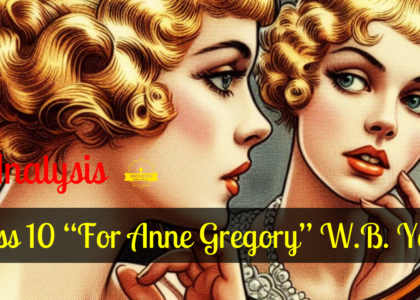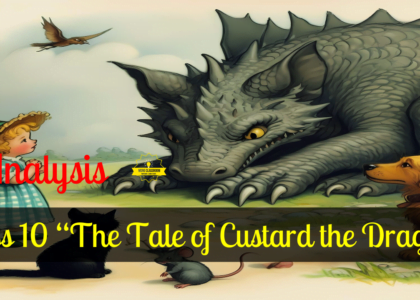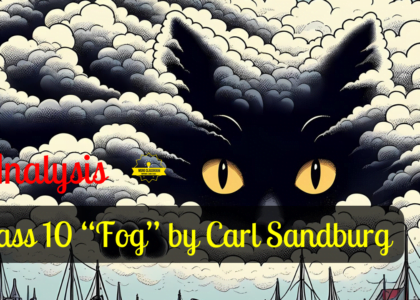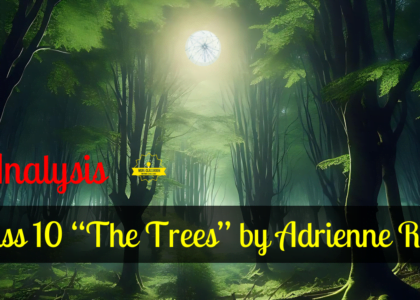Poem 3, Leslie Norris’ ‘A Tiger in the Zoo’ Explanation, Summary, Analysis, Literacy Devices, Questions Answers and Extra Questions.
Poem 3- A Tiger in the Zoo by Leslie Norris:
Leslie Norris
Leslie Norris (1921 –2006) was a Welsh poet, short story writer, and novelist known for his insightful portrayal of rural life and human connections. His works often explored themes of nature, family, and the passage of time. Norris’s writing style was marked by simplicity and depth, as he beautifully captured the essence of Welsh landscapes and the resilience of its people.

Table of Contents
Next on First Flight: ‘Two Stories About Flying-Part 1‘ , ‘How to Tell Wild Animals‘ by Carolyn Wells,
Summary “A Tiger in the Zoo”:
‘A Tiger in the Zoo’ by Leslie Norris is a poem that explores the captivity of a majestic tiger in a zoo. The poem conveys a sense of the tiger’s longing for freedom and the stark contrast between its natural habitat and the confines of the zoo. The tiger is described as stalking within the limited space of its cage, adorned with stripes. Despite its quiet and controlled movements, there’s an underlying rage and frustration. The poem suggests that the tiger yearns for the freedom it once had. Ultimately, the poem serves as a metaphor for the human condition, highlighting the consequences of restricting instincts and the longing for liberation.
Central Idea: A Tiger in the Zoo:
Leslie Norris’ ‘A Tiger in the Zoo’ reflects on the captivity of a majestic tiger within the confines of a zoo. Through vivid imagery and poignant language, the poem explores the themes of confinement, longing for freedom, and the inherent wildness of nature. The central idea revolves around the stark contrast between the tiger’s natural habitat and its artificial environment in the zoo. Despite being fed and sheltered, the tiger remains restless, symbolising the human desire for freedom and the yearning to be true to one’s nature. Ultimately, the poem serves as a metaphor for the human condition, highlighting the consequences of restricting instincts and the longing for liberation.
A Tiger in the Zoo Explanation:
The poem ‘A Tiger in the Zoo’ by Leslie Norris reflects on the captivity of a majestic tiger in a zoo. The poet describes the tiger’s vivid stripes and notes how it stalks back and forth within its confined space, showing signs of quiet rage. The poet contrasts the tiger’s natural habitat, where it should be lurking in shadows and hunting in the jungle, with its current state of being locked in a concrete cell.
The poet suggests that the tiger should be free, roaming near water holes and terrifying the village, but instead, it is confined behind bars, unable to express its true nature. The tiger’s strength and ferocity are wasted in captivity, as it is reduced to pacing in its cage and ignoring visitors.
The poem also touches upon the tiger’s awareness of its captivity. The tiger hears the sounds of the outside world, like patrolling cars and voices, and gazes at the stars in the night sky, perhaps longing for its true home in the wild.
In ‘A Tiger in the Zoo,’ Leslie Norris evokes sympathy and sadness for the caged tiger, highlighting the consequences of humans confining wild animals for public display and the loss of their instincts and freedom. The poem is a powerful commentary on the ethical implications of keeping animals captive for human entertainment.
Let’s start with a stanza-wise explanation of the poem.
- Stanza 1
The first stanza introduces the central character, a tiger, who is depicted as confined in a cage. The phrase “vivid stripes” emphasises the tiger’s majestic appearance. Despite captivity, the tiger’s movement is described as quiet and controlled, suggesting suppressed anger and frustration.
- Stanza 2
In this stanza, the speaker reflects on what the tiger’s natural habitat should be like. The tiger is imagined “lurking in shadow” and “sliding through long grass” near a water hole where it can hunt for prey. Using the word “plump” to describe the deer emphasises the tiger’s predatory nature.
- Stanza 3
The third stanza further highlights the tiger’s natural behaviour as a predator. The tiger is imagined “snarling around houses” at the jungle’s edge, instilling fear and terrorising the nearby village. The mention of “white fangs” and “claws” portrays the tiger as a fearsome and powerful creature.
- Stanza 4
In contrast to its natural habitat, the tiger is now depicted as being confined in a concrete cell, a symbol of captivity. The word “locked” emphasises the tiger’s lack of freedom, and the phrase “his strength behind bars” conveys a sense of imprisonment and confinement.
- Stanza 5
The tiger is described as pacing back and forth in its cage, ignoring the visitors who come to see it. This suggests a sense of resignation and a loss of its wild instincts as it has become accustomed to its captive environment.
- Stanza 6
In the final stanza, the speaker conveys the loneliness and isolation experienced by the tiger. The tiger listens to the sounds of civilisation outside its cage, such as the “last voice at night” and the “patrolling cars.” The mention of “brilliant eyes” and “brilliant stars” contrasts the tiger’s natural habitat and its current situation, highlighting the stark difference between freedom and captivity.
Analysis “A Tiger in the Zoo”:
‘A Tiger in the Zoo’ by Leslie Norris delves into the theme of captivity and the loss of freedom. Through vivid imagery and strong emotions, the poet explores the plight of a majestic tiger confined to a concrete cage in a zoo.
The poem begins with a powerful image of the tiger “stalking in his vivid stripes” within the confines of his cage. The word “stalks” implies the tiger’s natural hunting instincts, but it is now limited to pacing within the small space of the cage. The repetition of “quiet” emphasises the silent rage and frustration the tiger feels in captivity.
The poet contrasts the tiger’s present state with what it should be in the wild – “lurking in shadow” and “sliding through long grass.” The description of the tiger snarling and terrorising the village highlights its natural habitat and role as a fierce predator.
Enjambment in lines like “He should be snarling around houses / At the jungle’s edge” adds a sense of continuous motion, further emphasising the tiger’s confinement in a static environment.
The poet emphasises the tiger’s strength and power, “His strength behind bars,” intensifying the tragedy of its captivity. The phrase “Ignoring visitors” conveys the tiger’s isolation, signifying its detachment from the outside world.
The contrast between the “patrolling cars” and “brilliant stars” symbolises the loss of the tiger’s natural habitat and the constricting environment of its captivity. The tiger’s “brilliant eyes” stare at the stars, hinting at its unfulfilled longing for the vastness of the wild.
Relevance of the poem’s Title :
The title ‘A Tiger in the Zoo’ immediately sets the context and theme of the poem. It suggests that the poem will explore the life of a tiger confined to a zoo, emphasising the contrast between its natural habitat and captivity.
Rhyme Scheme, Structure and Type:
The rhyme scheme of the poem is ABCD. The poem is in five quatrains. ‘A Tiger in the Zoo is an imagist poem.
Imagery:
The poet uses vivid imagery to evoke the senses and emotions. Descriptions like “vivid stripes,” “pads of velvet quiet,” and “brilliant eyes” create a strong visual image of the tiger’s physical appearance and emotions.
Metaphor:
The tiger’s “quiet rage” in the cage is a metaphor for suppressed anger and frustration. The “concrete cell” and “bars” symbolise the constraints and confinement imposed upon the majestic creature.
Juxtaposition:
The poem explores the stark contrast between the tiger’s natural habitat and its current environment. The images of “long grass” and “water hole” in the wild are juxtaposed with the “concrete cell” and “jungle’s edge” at the zoo, highlighting the loss of the tiger’s freedom and instincts.
Tone:
The tone of the poem is melancholic and reflective. The poet’s use of strong emotions, such as “rage” and “terrorizing,” conveys a sense of sadness and sympathy for the tiger’s plight.
Personification:
The tiger is personified through its actions, such as “stalking,” “snarling,” and “staring,” giving it human-like qualities and emotions. This humanisation further intensifies the reader’s connection with the tiger’s suffering.
Enjambment:
The use of enjambment throughout the poem creates a flowing and continuous narrative, symbolising the repetitive and monotonous life of the caged tiger.
Theme ‘A Tiger in the Zoo’:
- Captivity:
The poem’s primary theme revolves around the concept of captivity. The tiger, once a free and powerful creature in its natural habitat, is now confined to a concrete cage in a zoo. The poem delves into the tiger’s emotions and experiences as it copes with the loss of freedom and the constraints of captivity.
- Freedom vs. Confinement
The poem contrasts the tiger’s current state of confinement with its natural freedom in the wild. The vivid imagery of the tiger “lurking in shadow” and “sliding through long grass” in its natural habitat underscores the stark contrast between its past life and its present captivity.
- Loss of Instincts
Another theme explored in the poem is the loss of the tiger’s instincts and behaviour due to captivity. In the wild, the tiger would “snarl around houses” and “terrorize the village,” but in the zoo, it is reduced to pacing the length of its cage and ignoring visitors.
- Human Exploitation
The poem touches upon the ethical issue of human exploitation of wild animals for entertainment. The tiger’s captivity in a concrete cell, behind bars, symbolises humans’ dominance over nature and the commodification of wildlife for human amusement.
- Isolation and Loneliness
The poem conveys the isolation and loneliness the tiger experiences in captivity. Despite being surrounded by visitors and patrolling cars, the tiger remains detached from the outside world, longing for the vastness of its natural environment.
- Empathy and Compassion
The poet evokes empathy and compassion in readers as they witness the tiger’s plight and the tragic consequences of its confinement. The reader is encouraged to empathise with the captive tiger and question the morality of keeping wild animals in zoos.
Through ‘A Tiger in the Zoo,’ Leslie Norris effectively portrays the confinement and loss of freedom experienced by the tiger, evoking empathy and compassion from readers. The poem serves as a powerful reminder of the importance of preserving the natural habitats of these magnificent creatures and allowing them to roam freely in their natural environments.
Line-by-Line Explanation “A Tiger in the Zoo”:
1. “He stalks in his vivid stripes”
The poet describes the tiger in the cage, moving gracefully with its distinctive stripes.
2. “The few steps of his cage”
The tiger’s movement is limited to the small space of its enclosure.
3. “On pads of velvet quiet”
The tiger’s paws are soft and silent, highlighting its graceful presence.
4. “In his quiet rage”
The tiger’s suppressed anger and frustration are apparent as it longs for freedom.
5. “He should be lurking in shadow”
The poet imagines the tiger in its natural habitat, camouflaged and waiting to pounce on prey.
6. “Sliding through long grass”
The tiger’s movements in the wild are fluid and unconfined.
7. “Near the water hole”
A common location for tigers to find water and prey in their natural environment.
8. “Where plump deer pass”
The poet refers to the tiger’s typical prey in the wild.
9. “He should be snarling around houses”
The poet envisions the tiger roaming freely near human settlements, displaying its fierce nature.
10. “At the jungle’s edge”
The tiger’s natural habitat borders human settlements in this context.
11. “Baring his white fangs, his claws”
The tiger’s predatory and intimidating traits are depicted.
12. “Terrorizing the village!”
The poet suggests the fear the tiger would evoke in the village.
13. “But he’s locked in a concrete cell”
The tiger’s current reality is confined within an artificial enclosure.
14. “His strength behind bars”
The cage restricts the tiger’s powerful physique.
15. “Stalking the length of his cage”
The tiger paces back and forth in its limited space, yearning for freedom.
16. “Ignoring visitors”
The tiger appears disinterested or unaffected by the visitors who observe it.
17. “He hears the last voice at night”
The tiger is attuned to the sounds around him, including the last human visitors at night.
18. “The patrolling cars”
The tiger can hear the sounds of vehicles patrolling the zoo.
19. “And stares with his brilliant eyes”
The tiger’s intense and captivating gaze is described.
20. “At the brilliant stars”
The tiger looks up at the stars in the night sky, perhaps yearning for the vastness and freedom of the wild.
Literary Devices “A Tiger in the Zoo”:
Questions Answers “A Tiger in the Zoo”:
Textbook Questions Answers:
1. Read the poem again, and work in pairs or groups to do the following tasks.
(i) Find the words that describe the movements and actions of the tiger in the cage and in the wild. Arrange them in two columns.
A(i) Words describing the movements and actions of the tiger:
In the cage: stalks, pads, quiet, rage, ignoring
In the wild: lurking, sliding, snarling, baring, terrorising
(ii) Find the words that describe the two places, and arrange them in two columns.
A(ii) Words describing the two places:
In the cage: concrete cell, bars, length of his cage, visitors, patrolling cars
In the wild: shadow, long grass, water hole, jungle’s edge, houses, village, brilliant stars
Now try to share ideas about how the poet uses words and images to contrast the two situations.
A: The poet contrasts the two situations through imagery and language. In the cage, words like “concrete cell,” “bars,” and “length of his cage” evoke feelings of confinement and restriction. The tiger’s actions within the cage, such as “stalking” and “ignoring visitors,” suggest a sense of restlessness and frustration.
2. Notice the use of a word repeated in lines such as these:
(i) On pads of velvet quiet,
In his quiet rage.
(ii) And stares with his brilliant eyes
At the brilliant stars.
What do you think is the effect of this repetition?
A: i) The word “quiet” is repeated in the lines “On pads of velvet quiet, In his quiet rage” to create a contrast between the tiger’s external appearance and internal state. The first instance of “quiet” describes the tiger’s calm movements, while the repetition of “In his quiet rage” highlights the paradoxical nature of its emotions. This contrast adds depth to the tiger’s characterisation.
(ii) In the lines “And stares with his brilliant eyes At the brilliant stars,” the repetition of the word “brilliant” emphasises the brightness and intensity of both the tiger’s eyes and the stars in the sky. This repetition amplifies the vividness of the imagery, creating a sense of heightened sensory experience for the reader. The repetition of “brilliant” highlights the tiger’s acute perception, keen observation of its surroundings, and grandeur of the natural world.
3. Read the following two poems — one about a tiger and the other about a panther. Then discuss:
Are zoos necessary for the protection or conservation of some species of animals? Are they useful for educating the public? Are there alternatives to zoos?
A3: Zoos serve conservation and educational roles, but ethical alternatives like sanctuaries prioritise animal welfare while engaging the public.
- Necessity of Zoos for Conservation: Zoos can play a crucial role in protecting and conserving certain species, particularly those facing extinction or habitat loss. Zoos contribute to genetic diversity and species preservation through captive breeding programs and conservation initiatives.
- Educational Benefits: Zoos serve as valuable educational resources, allowing the public to learn about diverse ecosystems and the importance of wildlife conservation. They enable people to engage with animals up close, fostering empathy and understanding.
- Alternatives to Zoos: While zoos have benefits, alternative conservation approaches such as wildlife reserves, sanctuaries, and protected natural habitats offer more ethical species preservation. These alternatives prioritise animals’ welfare while allowing for research, education, and public engagement in conservation efforts.
4. Take a point of view for or against zoos, or even consider both and write a couple of paragraphs or speak about this topic for a few minutes in class.
Sample Paragraph:
| Zoos are vital for conservation efforts, providing sanctuary for endangered species and contributing to breeding programs crucial for species survival. Also, they offer educational opportunities, allowing visitors to connect with wildlife and gain awareness about conservation issues. However, the confinement and display of animals in zoos raise ethical concerns. Many argue that captivity compromises animals’ natural behaviours and welfare, leading to stress and diminished quality of life. Moreover, the educational value of zoos can sometimes be overshadowed by the spectacle they offer, potentially perpetuating misconceptions about wildlife and habitat conservation. Therefore, while zoos play a significant role in conservation and education, continual evaluation and improvement are needed to ensure that ethical standards are upheld and that alternative approaches prioritising animal welfare are implemented where possible. |
Extra Questions: “A Tiger in the Zoo”:
Q1: What does the tiger’s behaviour in the poem signify?
A1: The tiger’s behaviour in the poem signifies its frustration and unhappiness with its captivity. The pacing and stalking in the cage show the tiger’s restlessness and longing for the freedom it once had in the wild.
Q2: How does the poet use imagery to convey the tiger’s emotions?
A2: The poet uses vivid imagery, such as “vivid stripes,” “pads of velvet quiet,” and “brilliant eyes,” to create a clear mental picture of the tiger’s physical appearance. Additionally, the image of the tiger stalking in its cage and ignoring visitors helps convey its feelings of captivity and detachment.
Q3: What is the significance of the title ‘A Tiger in the Zoo’?
A3: The title “A Tiger in the Zoo” sets the poem’s context, indicating that the focus will be on a tiger’s life in captivity rather than its natural habitat. The title foreshadows the theme of confinement and serves as a reminder of the tiger’s loss of freedom.
Q4: What is the tone of the poem?
A4: The poem’s tone is sympathy and concern for the tiger’s plight. The poet’s vivid imagery and strong emotions highlight the tiger’s suffering and emphasise the injustice of keeping wild animals in zoos.
Q5: How does the poem convey the importance of preserving natural habitats for wild animals?
A5: The poem conveys the importance of preserving natural habitats for wild animals by showing the stark contrast between the tiger’s natural behaviour in the wild and its captivity in a zoo. It serves as a reminder that wild animals should be allowed to live freely in their natural environment, where they can exhibit their true nature and thrive as they are meant to be.
Q6: How does the poet describe the tiger’s physical appearance?
A6: The poet describes the tiger’s appearance as having “vivid stripes” and walking on “pads of velvet quiet.” The tiger is also depicted as having “brilliant eyes” that stare at the “brilliant stars.”
Q7: What emotions does the tiger feel in its captivity?
A7: In its captivity, the tiger feels frustration and quiet rage. The poet suggests that the tiger should be in its natural environment, hunting and snarling, but instead, it is confined to a concrete cell, unable to roam freely.
Q8: What are the contrasting images presented in the poem?
A8: The poem presents contrasting images of the tiger’s natural habitat and its confinement in a zoo. It contrasts the tiger stalking in its cage with how it should lurk in the shadows near the waterhole, hunting and terrorising its prey.
Q9: How does the tiger react to the visitors and its surroundings?
A9: The tiger ignores the visitors and the concrete cell it is confined in. It stalks back and forth in its cage, seemingly disinterested in its surroundings, as it longs for its freedom.
Q10: What does the poem say about the impact of captivity on wild animals?
A10: The poem portrays the negative impact of captivity on wild animals like the tiger. It suggests that captivity robs them of their instincts, strength, and freedom, leading to frustration and a sense of being trapped. The tiger’s confinement in the zoo starkly contrasts its natural habitat, where it would be free and in control of its surroundings.
Extract Based Questions “A Tiger in the Zoo”:
Extract 1:
“He stalks in his vivid stripes
The few steps of his cage,
On pads of velvet quiet,
In his quiet rage.”
Q1: How is the tiger’s movement described in this extract?
A1: The tiger’s movement is described as stalking within the few steps of his cage, creeping on velvet pads, with an underlying sense of quiet rage.
Q2: What is the significance of describing the tiger’s rage as “quiet”?
A2: Describing the tiger’s rage as “quiet” suggests that while the tiger may appear calm, there is a deep-seated frustration and longing for freedom beneath the surface.
Q3: The above lines vividly describe the tiger’s movements and emotions within its confined space. How do these lines capture the conflicting emotions of the tiger and convey the theme of captivity and frustration?
A3: The lines “He stalks in his vivid stripes / The few steps of his cage, / On pads of velvet quiet, / In his quiet rage” from Leslie Norris’s “A Tiger in the Zoo” encapsulate the paradoxical emotions and situation of the captive tiger. “vivid stripes” highlights the tiger’s outward appearance, representing its wild and powerful nature. However, the tiger’s pacing within the “few steps of his cage” symbolises its limited, monotonous existence.
The phrase “On pads of velvet quiet” creates a stark contrast between the silence of the tiger’s movements and the underlying “quiet rage” it harbours. The tiger’s outward calmness belies the inner turmoil and frustration it experiences in captivity.
These lines effectively convey the poem’s central theme: the captivity of wild creatures and the stark difference between their instincts and confinement restrictions. The tiger’s “quiet rage” represents its longing for freedom and the inner conflict it faces, trapped within the confines of the zoo. The poet invites readers to reflect on the ethical implications of keeping such magnificent creatures in captivity, as the tiger’s quiet rage becomes a metaphor for the loss of its true nature and vitality.
Extract 2:
“But he’s locked in a concrete cell,
His strength behind bars,
Stalking the length of his cage,
Ignoring visitors.”
Q1: What is the tiger’s physical condition in this extract?
A1: In this extract, the tiger is described as locked in a concrete cell, with its strength confined behind bars.
Q2: How does the tiger react to the visitors mentioned in this extract?
A2: The tiger is said to ignore the visitors, suggesting that it is disinterested or perhaps resentful of their presence, as it longs for the freedom it once had.
Q3: How does the poet vividly depict the tiger’s captivity and emotional state through the lines, “But he’s locked in a concrete cell, / His strength behind bars, / Stalking the length of his cage, / Ignoring visitors”?
A3: The lines “But he’s locked in a concrete cell, / His strength behind bars, / Stalking the length of his cage, / Ignoring visitors” in Leslie Norris’s poem “A Tiger in the Zoo” poignantly encapsulate the stark contrast between the tiger’s natural, wild essence and its confined, captive state. The concrete cell symbolises the rigid, imprisoning environment restricting the tiger’s freedom. The phrase “His strength behind bars” underscores the loss of its inherent power and vitality, rendering it powerless.
The act of “stalking the length of his cage” reflects the tiger’s restlessness and pent-up energy, aching for the vast expanses of its natural habitat. Its indifference to visitors represents a poignant detachment from the human world, perhaps signifying a longing for the wild and a sense of frustration.
Overall, these lines vividly depict the physical and emotional captivity of the tiger, emphasising its desire for the freedom and life it once knew beyond the confines of the zoo.
Extract 3:
“He should be lurking in shadow,
Sliding through long grass
Near the water hole
Where plump deer pass.”
Q1: What does the poem suggest about where the tiger should be in its natural habitat?
A1: The poem suggests that in its natural habitat, the tiger should lurk in shadows, slide through long grass near waterholes, and hunt plump deer.
Q2: How does the description of the tiger’s natural habitat contrast with its current situation in the zoo?
A2: The description of the tiger’s natural habitat emphasises freedom, stealth, and hunting, in contrast to its confinement in a cage within the zoo, where it cannot engage in these natural behaviours.
Q3: In the poem “A Tiger in the Zoo” by Leslie Norris, how does the poet’s description of the tiger’s natural habitat in the abovementioned lines contrast with the tiger’s current existence in captivity?
A3: The selected lines vividly depict the tiger’s natural habitat and behaviours. These lines describe the tiger’s rightful place in the wild, where it is a powerful and majestic predator.
In these lines, the poet contrasts the tiger’s natural, predatory life with its current captivity in a concrete cell within a zoo. While the tiger “should be lurking in shadow” and moving stealthily through tall grass, it is confined to a small space, unable to exercise its hunting instincts. The image of the water hole where plump deer pass highlights the tiger’s role as a top predator now denied to it.
The stark contrast highlights the loss of the tiger’s freedom and natural behaviours due to captivity. It prompts reflection on the ethical and moral implications of confining such magnificent creatures for human entertainment, depriving them of their instinctual lives in the wild.
Extract 4:
“He hears the last voice at night,
The patrolling cars,
And stares with his brilliant eyes
At the brilliant stars.”
Q1: According to this extract, what does the tiger hear at night?
A1: According to the section, the tiger hears the last human voices at night and the sounds of patrolling cars.
Q2: How does the tiger’s behaviour towards the brilliant stars contrast with its behaviour towards visitors in the zoo?
A2: The tiger in the zoo ignores the visitors, but in this extract, it is described as staring with its brilliant eyes at the bright stars, suggesting a connection to the vastness of the night sky and a yearning for freedom represented by the stars.
Q3: In the final stanza of “A Tiger in the Zoo”, how do these lines encapsulate the poem’s central theme regarding the tiger’s captivity and longing for freedom?
A3: The closing stanza of “A Tiger in the Zoo” captures the essence of the poem’s central theme — the poignant contrast between captivity and freedom, symbolised by the tiger’s yearning for its natural habitat. The line “He hears the last voice at night” evokes a sense of isolation, signalling the end of human presence in the zoo. The mention of “patrolling cars” highlights the tiger’s confinement and the boundaries imposed upon it.
However, the most striking element lies in the tiger’s gaze on the “brilliant stars.” Here, the stars represent the vast, open expanse of the wild, the untamed world beyond its cage. The tiger’s “brilliant eyes” suggest a longing for the night sky’s freedom, mystery, and grandeur. It’s a poignant reminder that, despite being physically confined, the tiger’s spirit remains wild and unbroken, yearning for the brilliant expanse of its natural home. In these lines, the poem encapsulates the tiger’s silent plea for liberation and its eternal connection to the untamed world beyond its cage.
Extract 5:
“He should be snarling around houses
At the jungle’s edge,
Baring his white fangs, his claws,
Terrorising the village!”
Q1: What does the poem suggest the tiger should be doing in its natural habitat?
A1: The poem suggests that in its natural habitat, the tiger should be snarling around houses at the jungle’s edge, baring its white fangs and claws, and terrorising the village.
Q2: In this stanza, how does the poet contrast the tiger’s natural behaviour and its current state in the zoo?
A2: In this stanza, the poet emphasises the difference by describing the tiger’s predatory and menacing behaviour in the wild, starkly contrasting its passive and confined state in the zoo. This highlights the tiger’s loss of its instincts and freedom.
Q3: The selected lines vividly describe the tiger’s expected behaviour in its natural habitat, contrasting it with its captivity in the zoo. How does this stanza encapsulate the theme of captivity and the stark difference between the tiger’s wild instincts and confined state?
A3: The third stanza of “A Tiger in the Zoo” poignantly encapsulates the theme of captivity and highlights the stark disparity between the tiger’s instincts and constrained existence. The lines, “He should be snarling around houses / At the jungle’s edge, / Baring his white fangs, his claws, / Terrorizing the village!” vividly depict the tiger’s natural behaviour in the wild.
In its native habitat, the tiger embodies the apex predator, snarling and baring its fangs and claws as it roams freely. It becomes a symbol of terror, the ruler of its domain. However, the poem contrasts this with the tiger’s current situation in the zoo, where it is stripped of its natural behaviours and instincts. It’s no longer the fearsome creature of the jungle but a captive, pacing within the confines of a concrete cell.
The stanza powerfully conveys the loss of the tiger’s true essence and the price it pays for human curiosity and captivity. It serves as a poignant commentary on the tragic consequences of depriving such majestic creatures of their freedom and natural habitat.





